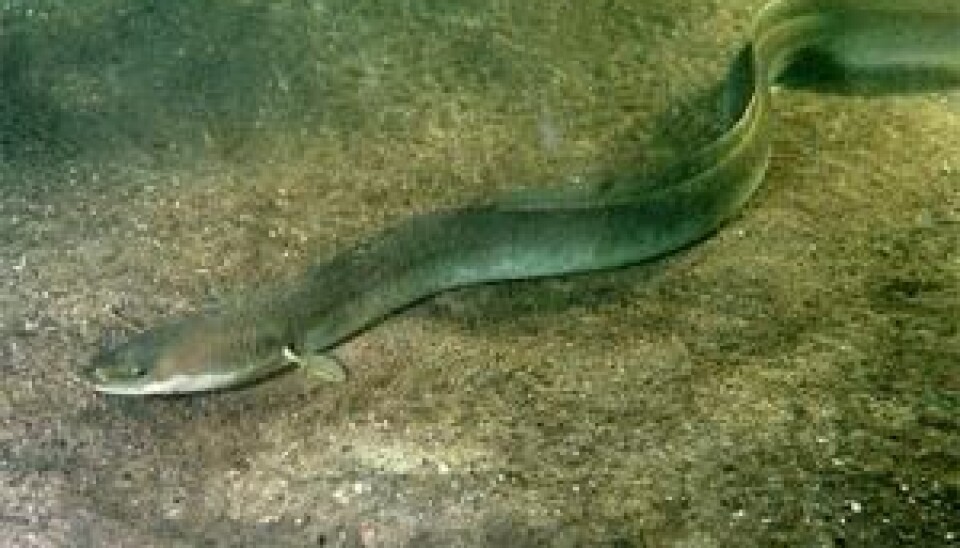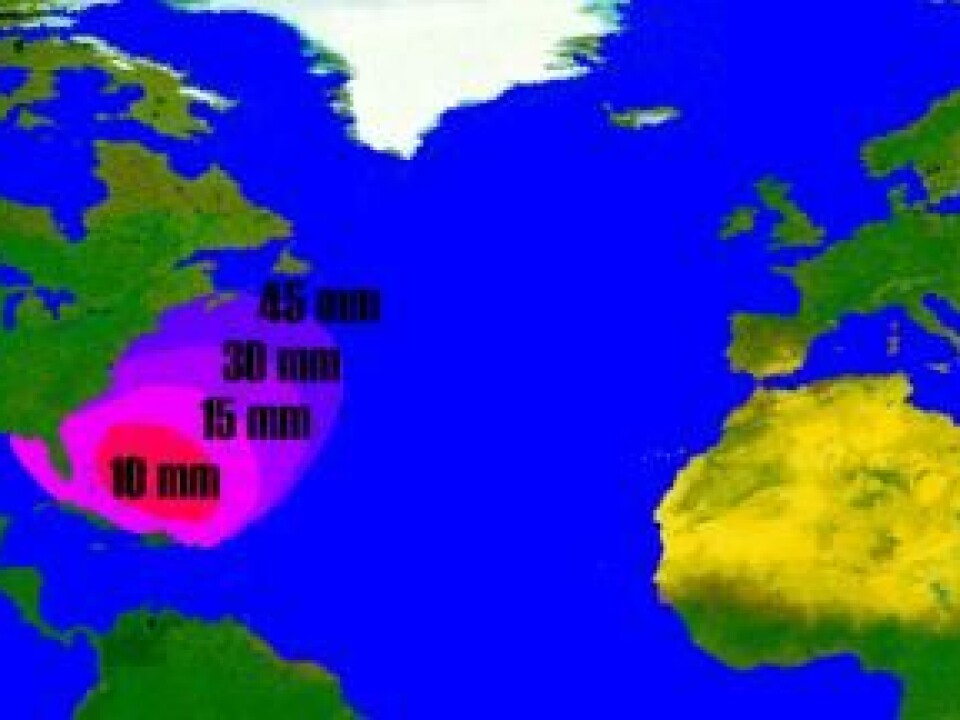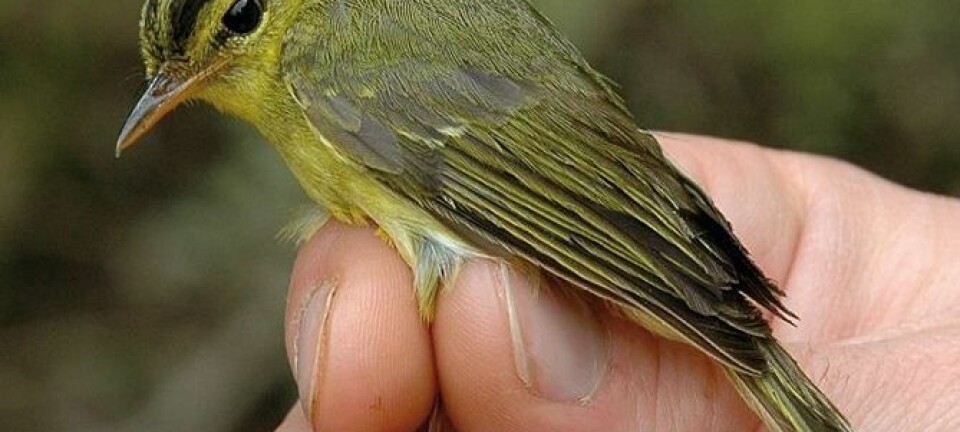
Scientists solve the riddle of eel evolution
European and American eels emerged as separate species 3.5 million years ago -- yet they can still breed with each other. Scientists can now tell us how.
How the American and European eels emerged as two independent species has long been shrouded in mystery.
Both groups breed in the same area in the Caribbean, the Sargasso Sea, but typically you would expect a long-term physical separation of the two, to allow them to develop in different directions. This makes them a great mystery of evolution.
Now scientists have solved this puzzle. It turns out that the eels became two species 3.5 million years ago, when Panama arose from the sea, separating the Atlantic and Pacific Oceans. One group of eels were led to Europe by the Gulf Stream, where a new species emerged.
“Eels have one of nature's most extreme life stories, and there is still a lot we don’t know about them. By understanding their evolution and life history, we can manage stocks better, ensuring that eels are plentiful in the future," says Professor Michael Møller Hansen from the Department of Bioscience at Aarhus University, Denmark.

Hansen and his team of researchers from Denmark, Canada, and Spain, have published six articles on eel life history in the scientific journals Biology Letters, Molecular Ecology, BMC Evolutionary Biology and Heredity, published by Nature Publishing Group, over the past year.
An epic 5,000-kilometre swim to breed
The eel’s life story is difficult to understand from an evolutionary perspective.
Take an eel in a Danish stream -- when it is time to mate, they do not choose the easy option and find an eel in the same river to breed with.
Instead, they embark on a perilous 5,000 kilometre journey to spawn in the Sargasso Sea.
The same goes for eels from all across Europe, and in this way they comprise a single population of European eels that all go to breed on the other side of the Atlantic.
After the breeding season is over, the new eel larvae float all the way back to Europe, following the Gulf Stream and other ocean currents. A few years later, they settle in coastal waters, rivers, and lakes. They can be found in Iceland and Norway in the north, all the way down to Morocco in the south, and this epic life cycle begins all over again.
But the Sargasso Sea is not the reserve of European eels -- American eels also breed there, and the two breeding areas overlap. Sometimes the two species also breed with each other, which has been difficult to explain.
"If the two eels can breed together and have fertile fry [juveniles], and their breeding grounds are not separated, it is very difficult to see how the two species arose. So, we wanted to find out," says Hansen.
The rise of Panama formed two eel species
Hansen and colleagues looked at two events that could have created the conditions for the formation of two separate species.
One was the beginning of the Ice Ages, 2.5 million years ago; the other was the formation of the Isthmus of Panama, when Panama rose from the sea around 3.5 million years ago and separated the Atlantic and Pacific oceans.
To solve the mystery the scientists analysed the genomes of eel mitochondria, the cells' power plants handed down from mothers to their offspring. They analysed 50 European and 50 American eels, and compared their mitochondrial DNA.
They discovered the two species had gone their separate ways 3.4 million years ago -- coinciding with the rise of Panama land bridge between North and South America and marking the beginning of the formation of two independent species of eel.
"When the Atlantic was separated from the Pacific Ocean, it had important implications for climate and ocean currents. The Gulf Stream became stronger, and if the original eel species had only lived in North America, the stronger Gulf Stream could have led eel larvae to Europe, starting a whole new population there. This group would be under different evolutionary pressures than the original American eels," says Hansen.
"Ice ages may have affected eel populations later, so that breeding areas for the American eel and the European eel did not overlap very much in the Sargasso Sea. The two species were likely separated during ice ages and could develop in different directions,” he says.
Colleague: Exciting research
Senior scientists Kim Aarestrup from DTU Aqua also studies eels but has not been involved with the new studies.
He calls the new research very exciting because it illustrates how studies of eel genetics can provide deeper insights into eel evolution and life history than field observations can.
"Eel evolution is a mystery that we have struggled with for many years. It is interesting that these new data suggest the rise of Panama as crucial for creating two eel species. They are convincing results, providing weight to this theory," says Aarestrup.
Larval growth period varies for each species
In another study, scientists looked at the genetic differences between American and European eels that could mark them out as two separate species.
They analysed more than 300,000 genetic markers throughout the entire genome of European and American eels.
The genomes were virtually the same, except for a couple of differences in a few very specific parts -- those affecting growth and metabolism.
This makes sense, says Hansen, as the American eel only exists as larvae for six to nine months, while the European eel’s larval stage can last for a few years.
“American eel larvae only float with the Gulf Stream 1,500 kilometres to reach the nursery areas along the North American coast. European eels, on the other hand, make a journey of more than 5,000 kilometres,” he says.
“So it makes sense that they have taken separate evolutionary directions when it comes to growth during the larval stage and changes in energy metabolism according to whether the journeys are long or short for both adult eels and larvae. This has helped to form the basis of speciation," says Hansen.
Hybrids end up in Iceland
Although the American eel and the European eel are two different species, they can still breed with one and other, which they do from time to time.
Curiously, these offspring do not end up in mainland Europe or North America, but in Iceland where they make up over ten per cent of the Icelandic eel population.
Hansen and his team believe they know why.
"We believe that the larval phase of these hybrid offspring is somewhere between that of the European eel and the American eel. They come out of the larval stage as they float along with the Gulf Stream in the middle of the Atlantic Ocean. So there is only one place they can settle down and survive, and that is Iceland,” says Hansen.
“Whilst the American eel has already “left the train”, the European eel continues on the train for a little longer, and in between, we find these hybrids," he says.
Icelandic eels have European mothers
A genetic study of the hybrids showed that all of the first generation hybrids have a European mother and an American father.
Scientists believe this is because the American eels spawn earlier in the season than the Europeans.
Male fish are often able to spawn longer than females, which may explain why all the Icelandic hybrids had American fathers.
"You can imagine that some of the hardiest American male eels 'linger in the disco' a little longer, and throw themselves on the European females when they arrive at the spawning areas," says Hansen.
Lastly, the scientists discovered some of the hybrids had American ancestry 2 to 5 generations back, showing that the hybrids are fertile and still interbreeding with their American counterparts, even though they became two distinct species 3.4 million years ago.
Important research that can help to conserve eels
According to Hansen, genetic research like this is important for maintaining eel populations.
The amount of eel larvae coming to Europe every year is down to only about two per cent of what it was before 1980.
The international organisation for nature conservation IUCN (International Union for the Conservation of Nature) has subsequently red listed the European eel as ‘critically endangered’ and it’s American cousin as ‘threatened’.
It is important to understand the life history of eels in order to manage them. This, according to the scientists behind the new research, is where their results may help.
For example, they show that all European eels are part of the same population. So conserving eels in one European country, but not the others, will have little overall effect on their numbers.
The new research also provides insights into the genetic variation of eels, which will be important in the future for fish farms aiming to breed eels.
Breeding programs can be better informed with this knowledge of the eel genome and specifically of the genes important for growth and survival under different environmental conditions.
"These studies have given us a lot of important tools to understand the eel’s special biology, and hopefully genomic tools can be used even more in future management work," says Hansen.
--------------
Read the Danish version of this article on Videnskab.dk
Translated by: Catherine Jex
Scientific links
- "Assessing patterns of hybridization between North Atlantic eels using diagnostic single-nucleotide polymorphisms", Heredity, DOI: 10.1038/hdy.2013.145
- "Genomic footprints of speciation in Atlantic eels (Anguilla anguilla and A. rostrata)", Molecular Ecology, DOI: 10.1111/mec.12896
- "Speciation and demographic history of Atlantic eels (Anguilla anguilla and A. rostrata) revealed by mitogenome sequencing", Heredity, DOI: 10.1038/hdy.2014.44
- "Relationship between amino acid changes in mitochondrial ATP6 and life-history variation in anguillid eels", Biology Letters, DOI: 10.1098/rsbl.2015.0014









